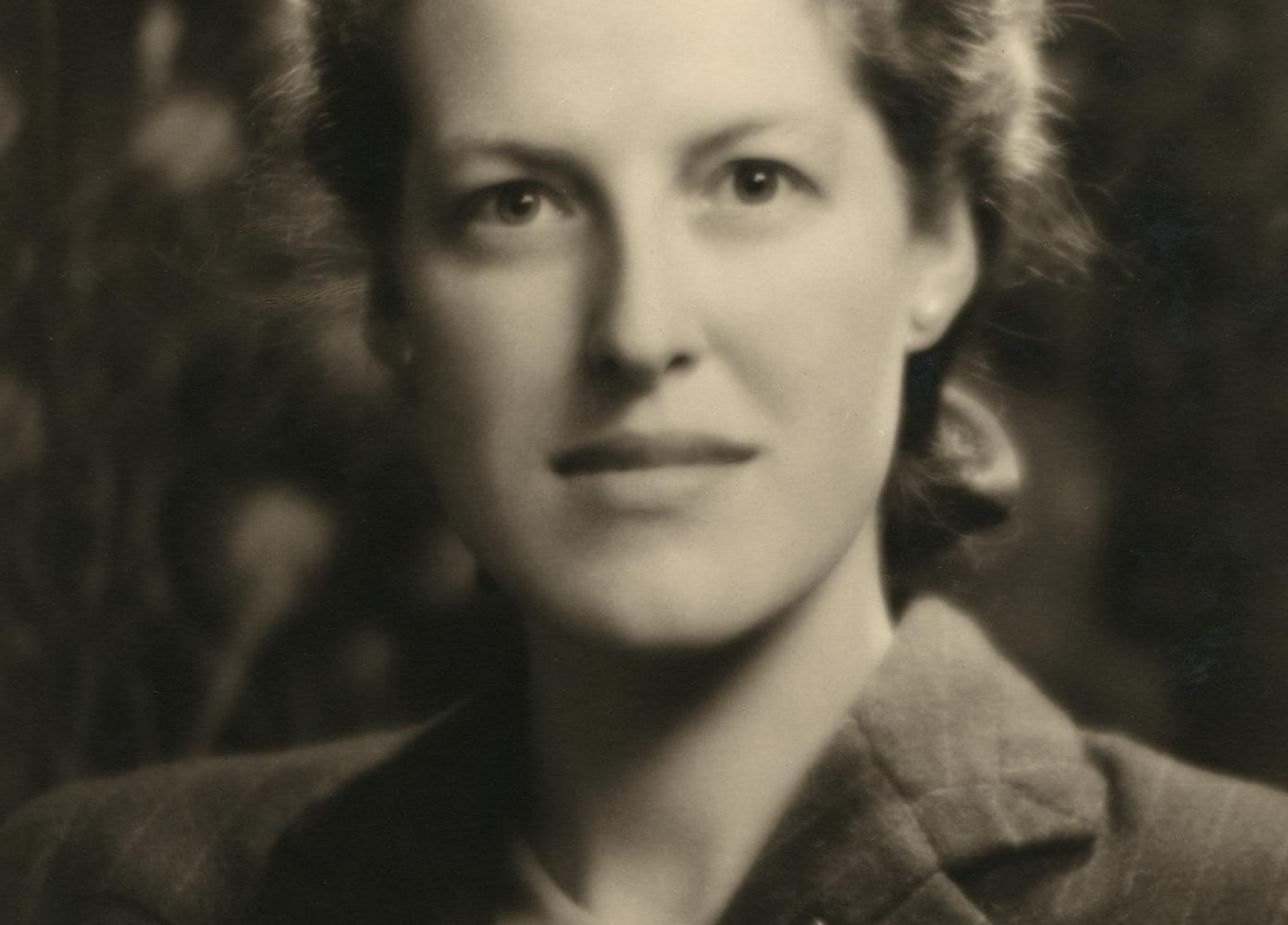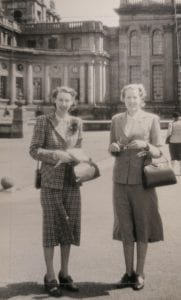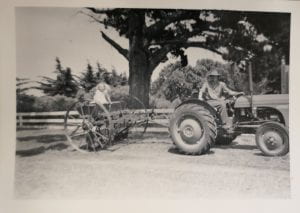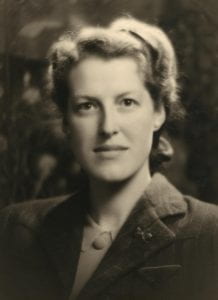
Margaret Kiddle and Us
As archivists we “discover” many unexpected things in the collections we process. It is rare to unexpectedly discover ourselves, though. In 2021-2022 as the Miegunyah Archivist working on the papers of prominent University of Melbourne figures, I did just that: records revealing my own brief acquaintance with University of Melbourne historian Margaret Kiddle.
Margaret Kiddle (1914-1958) was an historian and one of the early female academics at the University of Melbourne. In 1946 Kiddle became a tutor (later senior tutor) in the Department of History. She stayed there for the rest of her life, apart from a year (1952) spent document-hunting for Australian historical records in Britain[1] and another (1954) working as a research fellow at the Australian National University, Canberra. Her publications included Caroline Chisholm (1950), three books for children Moonbeam Stairs (1945), West of Sunset (1949) and The Candle (1950), and Men of Yesterday, A Social History of the Western District of Victoria 1834-1890.
Image: Margaret Kiddle (on right) with her sister Elizabeth outside Blenheim Palace during record hunting trip 1952. (2008.0047.00004. Elizabeth Bush Scrapbook)
UMA holds five collections of Kiddle papers: 1964.0002; 1988.0162 (volumes from Kiddle’s library); 1992.0042; 1996.0039; 2008.0047, all of which were reprocessed in the course of the Miegunyah Project. This project, funded by the Miegunyah Fund, has improved the discoverability of over 30 prominent university figures.
A correspondence file in the Margaret Kiddle Collection originally concisely tiled “Philip”, proved on inspection to be an extensive series of letters between my father Philip Brown (1904-1996) and Margaret Kiddle.[2] As a fellow historian of the Western District, Victoria and the editor of the Clyde Company Papers and The Narrative of George Russell, my father shared with Kiddle an encyclopaedic knowledge of the families and properties significant in Western District white settlement.
Always a generous scholar, the letters show my father’s willingness to share his research and knowledge with Kiddle, particularly as she worked on her magnum opus, a “social history” of the Western District of Victoria. Their correspondence began in 1949 and continued to just before her untimely death in 1958, by which time “Miss Kiddle” had become “Dearest Margaret”. [3]
Letters reveal Kiddle stayed at our farm outside Geelong at least once. My older brother recalls an elegant russet haired lady with a beneficent smile, who greeted him with a hug and warmly indulged a small boy’s intense interest in her green Morris Oxford car.
Maybe she also took a shine to the youngest child, a sturdy little girl in gumboots, stumping across the paddocks – a me I recall only from photographs – as I tunelessly intoned my mosquito song which Dad transcribed (embellished I expect) in a letter to Kiddle:
“Skeeto, Skeeto aren’t you bad!…
And the Skeeto said –
“I bounce on your arm,
And I make a little hole,
And I suck your blood,
And I make an itchy bump,
And then I fly away…” [4]
Our father’s elegant script on the “Allanvale, Leopold, Phone 14” letterhead, interleaved with typescript bashed out on his trusty journalist’s Remington, evoke wisps of memory from my early childhood. They take me back to family lore that this was our family’s golden age, a period when Dad was able to be both a farmer and an historian before factors, inexplicable to a young child, moved us into the city.
Image: The writer and her father Philip Brown, Allanvale, Leopold
The “Philip” file also houses one letter from my mother, Jean Howatson Brown (1914-2003), a voice almost absent in the public record. “Jymsie” writes to Margaret that she is “going up to town” the next day to see “Separate Tables”, and, showing the interconnected circles of many Victorian families at that time, that she “…shall also be seeing my stepmother about the flat that may interest your sister.” [5] This would have been one of the spacious flats at “Denby Dale”, the Tudor-style apartment block in Glenferrie Road, Kooyong built in 1938, in which our widowed “Grannie” resided.
Image: Margaret Kiddle, photograph by Jack Cato, 1946, University of Melbourne Archives, 1964.0002.00155
Margaret Kiddle’s death on 3 May 1958 from a lifelong congenital kidney disease cut short her work. Her completed manuscript, finished the week before she died and still untitled, was posthumously published. The editing and eventual publication of Men of Yesterday: A Social History of the Western District 1834-1890 by Melbourne University Press in July 1961 was stewarded by her colleagues, notably Professors John La Nauze and Max Crawford. Aware of her impending death Kiddle penned a letter a month before she died stating her wishes for the revision of her book and ending with the blacky humorous comment that “This book has been finished in dramatic circumstances – for publicity purposes cash in on them as much as you like…! [6] Kiddle willed the royalties from Men of Yesterday to the History School and The Margaret Kiddle Prize is awarded annually for the best final honours thesis in History.
Correspondence and extensive files of drafts and revisions show additional input from other historians, including Noel Butlin, Geoffrey Serle, Manning Clark, Russel Ward, anthropologist Bill Stanner, my father Philip Brown, who contributed to the biographical index and sourcing of illustrations, and many others, all of whom provided “critical comment and corrections”. Their work over the three years prior to publication does raise the question of what changes were made to Kiddle’s text after her death. [7]
It is not possible now to consider the history of the Victorian Western District without acknowledging the terrible price paid by Aboriginal inhabitants as the unceded lands were settled. And I can’t help but wonder how Kiddle and my father, two historians of similar age and background, would have treated this within their research areas now.
Primary source records were of key importance to both researchers, but pastoralists’ letters, diaries and station records hid much from posterity; the dominant narratives they read and edited were those of “advancement”, not dispossession. There was awareness by my father, but a view which from today’s perspective seems informed by a kind of historical determinism. In comments to Kiddle on her draft Chapter 6 “Morality” he noted that “Their impact on the balance of native life [was] not appreciated by the settlers” and “I think that we agree on the inevitability of what happened, and can both bear witness to the helpless unwillingness with which so many settlers saw it happen and contributed to the process.” [8]
Other historians were more overt in their embrace of the dominance of colonial history, the rationale appearing to be for some that Kiddle’s book was intended to be a “social history”. Advising on Chapter 1, John La Nauze commented to Kiddle, “I think you want some beaut quotation of a pioneer coming on the land – Mitchell or a pioneer settler – at the v. beginning…The whole point of the book is the white man in the land.” [9]
In addition to being a comprehensive research collection of primary sources, the Kiddle papers can provide insights into the historiography of the mid twentieth century, relationships between historians, the position of female academics, and the process of research, writing and editing.
And for me they have provided the unexpected personal pleasure of finding myself and my loved ones “in the records”.
Sarah Brown
[1] Typescript “Diary Letters” (originals) by Margaret Kiddle contain detailed descriptions of the “Record hunting” trip, in England, Scotland, Ireland, and travelling in the continent and Scandinavia, often driving herself and her travelling companions, who included her sister Elizabeth Bush, in her Morris Minor car referred to as “Minor”. The UK leg included trying to locate the lost portrait of Caroline Chisholm in Ireland and researching families who had emigrated to the Western District. (2008.0047.00002)
[2] 1964.002.00016 Philip Brown. Passim. The “other half” of this correspondence i.e., Margaret Kiddle’s letters to Philip Brown are held at the Geelong Heritage Centre Archives https://archives.grlc.vic.gov.au/ GRS 2070 – P.L. Brown Manuscript Collection. The P.L. Brown Collection contains many additional records relating to Kiddle’s research and writing.
[3] 1964.0002.128. Original criticisms and notes by friends: MK, March 1957. Kiddle notes “Philip Brown’s comments on plan of book and written chapters. See also his voluminously informative letters in special file (devoted to him) bookcase shelves”
[4] 1964.0002.00016. Philip Brown: Philip Brown/MK, 27 September 1955
[5] 1964.0002.00127. Critical notes on chapters [Margaret Kiddle]: MK, 5 April 1958
[6] 1964.0002.00127. Critical notes on chapters [Margaret Kiddle]: MK, 5 April 1958
[7] 1964.0002.00126. Critical notes on chapters. Passim. See also extensive drafts
[8] 1964.0002.00128. Original criticisms and notes by friends: Philip Brown/MK, 8 June 1954
[9] 1964.0002.00126. Critical notes on chapters: JLN in response to Bill Stanner comments and MK comments, undated
Categories



Leave a Reply